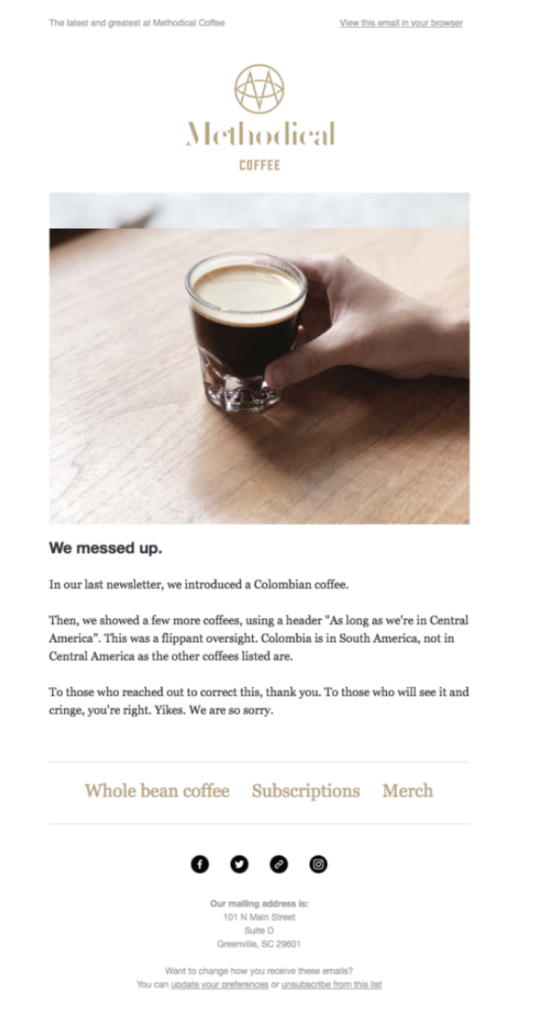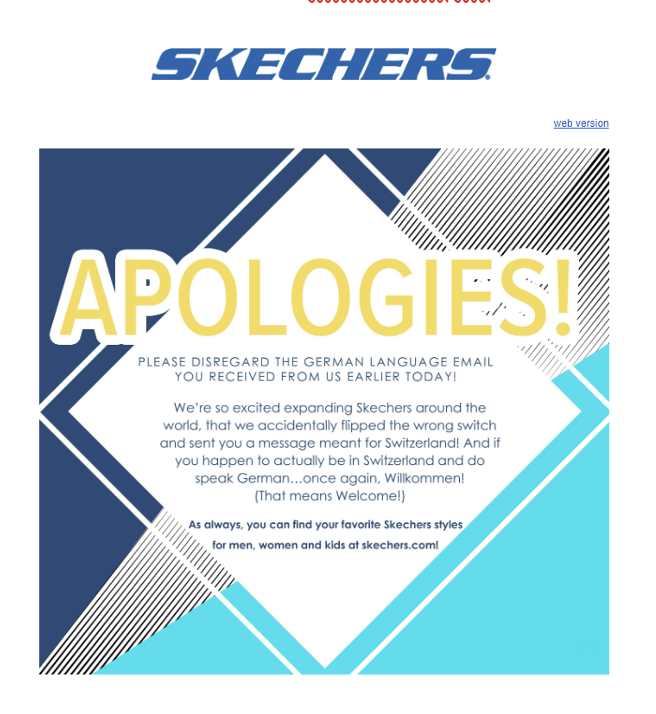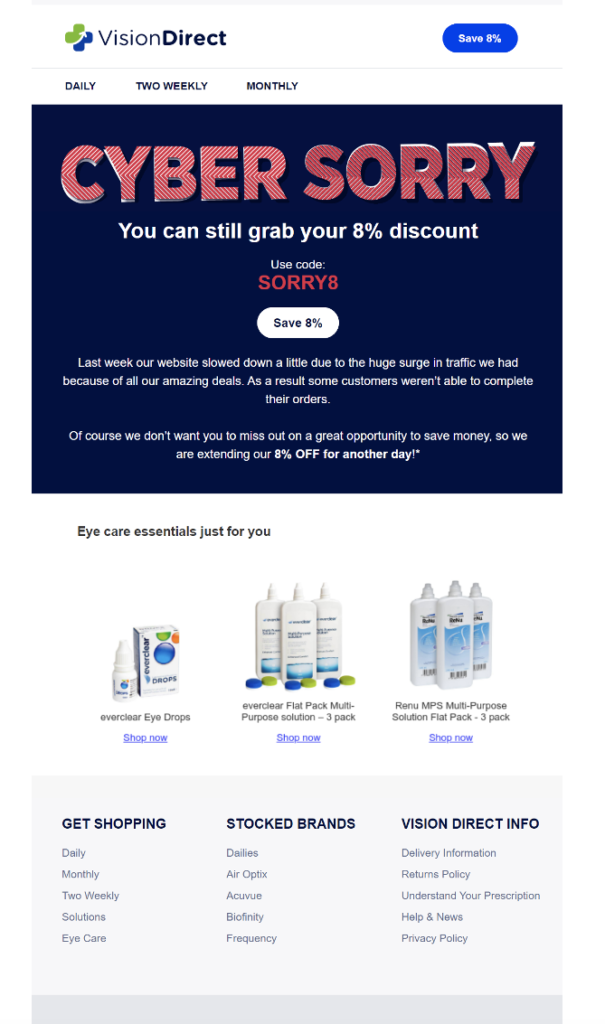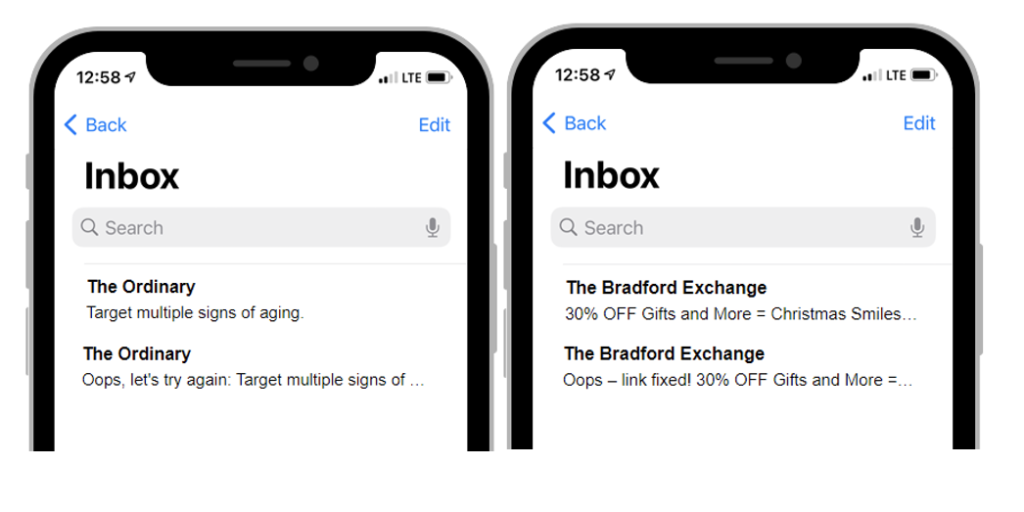
We’ve all been there: You’ve just clicked send only to notice you’ve missed a link, goofed up a personalization token, or promoted a product that’s out of stock.
You’ve committed an “email oops.”
At some point in every marketer’s career, there comes a campaign, which, despite rigorous Q&A, contains an error. In these moments, it’s tempting to send up a silent prayer to the email gods and hope the mistake will be overlooked—but after you hit send, there’s no going back.
Once an error is uncovered, marketers must act swiftly to issue a correction that mitigates damage and repairs the relationship between brand and subscriber.
When to send an oops email
Gone unaddressed, mistakes in email campaigns can be a serious problem. If the email included invalid links, led to a downed web page, or contained errors about a major promotion, your brand could face a serious loss in revenue.
While technical glitches account for many email mistakes, other scenarios can cause significant harm to your brand image. More and more, subscribers are choosing to interact with and purchase from brands that embody strong values and inclusivity. Sending an email with unempathetic or insensitive tones can lead your audience directly into the arms (or shopping carts) of competitors.
An oops email isn’t always necessary. A small formatting issue in the email’s footer might not merit a full-blown apology. However, if an error prevents subscribers from purchasing or could dissuade them from engaging with your company in the future, an oops email is a must.
The oops email checklist
Once the mistake has been found, marketers should gauge the scale of the problem and connect with subscribers in a direct and genuine manner.
Be sure to:
1. Act quickly
The holiday season is already well underway, and often, email promotions are time sensitive. To ensure subscribers can still take advantage of key sales events, send an oops email as soon as possible. In fact, some senders can even catch a mistake before the campaign has finished deploying.
In this case, senders should pause the email campaign and create a fix for remaining recipients. Be sure to segment your list so only subscribers who received the original error will receive an oops email.
2. Apologize
When subscribers opt in to your email program, they’re placing trust in your brand. In the event of an oops, a simple and authentic “we’re sorry” goes a long way toward repairing the 1:1 relationship you’re working so hard to build with subscribers. A well-crafted apology can help mitigate any complaints that come through your customer service or social channels.
3. Use a compelling subject line
From the subject line alone, it should be abundantly clear to your subscribers that the email contains a correction.
Sending the same campaign creative with the same subject line will look like a mistake in and of itself, and annoy subscribers by flooding their inboxes. Additionally, unique subject lines can help avoid campaign grouping some mailbox providers apply to duplicates.
4. Be specific about the correction
Whether the issue was a technical glitch or accidental use of offensive content, the oops email should provide subscribers a summary or overview of the issue. Making clear that an out-of-stock item was promoted, that the email was sent to the wrong person, or that your website was experiencing technical difficulties helps create rapport with your audience—and your customers will usually appreciate the transparency!
5. Offer a make-good incentive
Offering an enticing incentive can prompt subscribers to accept your apology, engage, and let bygones be bygones. Depending on the severity of the error, senders might consider free shipping, a special percent off promotion, or even a sale extension to ease any frustration the oops may have caused.
6. Outline next steps
An apology can seem meaningless without action. Let your subscribers know what happened and that you’re taking steps to ensure mistakes don’t become a habit. Whether you’re improving your testing process, investing in new technology, or making broader foundational changes as a business, be as transparent as possible with your audience.
Post-oops, marketers should consider revisiting design, testing, or Q&A processes to identify the root cause of the mistake and make necessary adjustments to prevent another accident.
Let’s take a look at some oops email examples that prove brands can turn a mistake into a major opportunity to connect with subscribers.
Framebridge
Sending to the wrong subscriber segment can constitute a critical marketing error. When Framebridge accidentally sent a last-touch, sunset email to engaged subscribers, they risked dramatically cutting their active list and negatively impacting their ROI.
To mitigate these risks, Framebridge sent this excellent oops email. The subject line clearly indicates a mistake was made and the email body includes a prominent apology. They explain the error, keep the message simple, and invite subscribers to share their thoughts by providing a clear contact method. Notably, they do not use the correction email as an excuse to promote products, which makes the apology feel genuine.
Subject Line: Our Mistake
Methodical Coffee
Sometimes, an email contains an error that strikes subscribers as insensitive, flippant, or just plain wrong. Methodical Coffee classified Colombia as a country located in Central America in a recent newsletter, and unsurprisingly, subscribers complained.
Methodical Coffee leveraged the email channel to issue a retraction and to help rebuild confidence with their subscriber base. They take this opportunity to address negative subscriber sentiment directly by acknowledging the error as cringe-worthy, apologizing, and validating subscriber feelings. As in the Framebridge example, the tone of the apology email reads as sincere because they have not included any promotional material.
Subject Line: *Retraction* On Colombia and our last email
Skechers
Wieviele Sprachen sprechen Sie? Presumably, a marketer’s most basic hope is that their audience can actually read an email’s content. Skechers’ English-speaking audience must have been at least slightly confused to receive a German language email, which was followed promptly by an apology.
With a little humor, Skechers turns this language oops into an opportunity to announce their global expansion. Their oops email follows best practices because it was issued quickly, offers an apology, indicates a correction in the subject line, and explains what happened. While this mistake doesn’t necessarily warrant a make-good discount, Skechers subtly directs subscribers to their website while keeping the apology front and center.
Subject Line: Oops! RE: Willkommen bei Skechers!
American Eagle
In certain scenarios, playfulness can be leveraged to smooth over technical issues that caused a negative subscriber experience. American Eagle injects some levity into their oops email with a witty subject line and a preheader that works to establish a site issue (Oops! Our site had some issues). The email is full of apologetic gems. Subscribers are offered a 25 percent off incentive and a promo code referencing the site glitch (NOGLITCH). American Eagle even incorporates a relevant, engaging GIF that hilariously illustrates the original error. Between the make-good offer and humor, American Eagle leverages an email mistake to endear themselves to their subscribers.
Subject Line: Son of a glitch
Vision Direct
A sale extension is exciting—whether it’s part of an apology or not. After a surge in traffic caused site problems, VisionDirect made amends with their audience by giving potentially frustrated subscribers another day to take advantage of a critical sale. By confirming which subscribers were unable to complete their purchases, this campaign is hyper-targeted. As an added bonus, they’ve managed to fold a cyber sale into their oops subject line and copy in a clever and creative way.
Subject Line: We’re cyber sorry that you couldn’t get your discount
The Ordinary & The Bradford Exchange
Subject lines play a pivotal role in effectively communicating email corrections and are especially important if your team doesn’t have the bandwidth or resources to build a new email. While we recommend a brief explanation in the email body, sometimes a descriptive subject line will have to do.
Consider these subject lines from The Ordinary and The Bradford Exchange. Neither brand altered the original email’s content, but both identified an oops via the subject line. There is one key difference—The Bradford Exchange explicitly notes a link issue in the previous version, while The Ordinary doesn’t specify the original error.
The Ordinary subscribers might be left scratching their heads about what was fixed (turns out, the primary call to action led to a 404 error). On the other hand, The Bradford Exchange’s audience had a clear picture of why they received two emails in such a short window.
Don’t sweat the small stuff
Despite our best efforts, mistakes happen. When they do, the best course of action is to issue an authentic apology that might even elevate your brand in the eyes of your subscribers.
For more inspiration from brands like these to fit any email marketing scenario, create a free MailCharts account and start searching!





